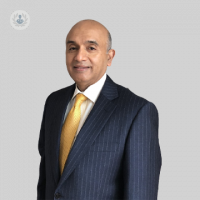Total knee replacement surgery: a detailed analysis
Escrito por:Total knee replacement surgery can significantly relieve knee pain for suffering patients and can so too do the world of good when it comes to restoring one’s overall knee function.
Here to explain what the surgery entails and the main reasons why patients undergo total knee replacement surgery is esteemed and leading consultant trauma and orthopaedic surgeon, Mr Dipen Menon.

When should someone consider undergoing a total knee replacement?
A total knee replacement is an operation that is performed to reduce pain and improve the quality of life in a person suffering from the consequences of a painful knee.
What causes knee pain and what are the main reasons why people undergo total knee replacements?
The most common cause of knee pain is an arthritic knee, although the knee can be replaced for many other reasons.
This procedure should only be performed when the pain is significantly intrusive (interferes with day-to-day activities) and not controlled with conservative treatment. The arthritis should be moderate or severe on examination and on imaging.
The knee is usually painful at rest and a person’s sleep can be disturbed as a result. The painful knee can oftentimes be swollen and stiff and the mobility can be severely restricted as a direct consequence of these problems. The person who suffers from this is usually an adult above the age of 60 and should be medically fit enough to cope with a major operation.
What does the surgical procedure involve exactly? How is it performed?
Total knee replacement is a surgical procedure where the diseased and worn-out bone and cartilage from the surface of the knee is removed and resurfaced with metal components called implants (made from a cobalt-chromium alloy) that are cemented to the thigh and shin bones. The metal components sandwich a very durable plastic bearing in between them.
The operation involves making a cut (surgical incision) in the front of the knee in the midline. The inside of the knee joint is exposed after cutting through the capsule of the joint. The ligaments inside the knee (the anterior and, sometimes, the posterior cruciate ligament), are sacrificed, depending on the degree of deformity in the knee.
The diseased and worn-out bone surfaces are then cut using a saw with the aid of special instruments (jigs) to accommodate the implants of the correct size on the cut surface of the bone. The knee is then straightened out by balancing the ligaments outside the knee which are preserved.
The trial components are then, at this stage, placed on the cut bone surfaces and the tension in the compartments of the knee is gauged and fine tuned. Once the surgeon is happy with the balance, the components are cemented onto the cut bone surfaces.
A sliver of bone at the back of the kneecap can also be removed, and a dome-shaped plastic button is cemented onto the cut bone surface, depending on the degree of wear behind the knee cap. The operative incision is closed with dissolvable stitches under the skin and staples (skin clips) or dissolvable stitches to close the skin.
The operation is performed under a regional (spinal) or general anaesthetic, and this decision is made by the anaesthetic team. The default option is to perform the procedure under a spinal anaesthetic.
The nerves supplying the knee joint may be blocked to relieve the pain after the operation. The operation is performed in a clean-air theatre with sterile instruments. Antibiotics are given just before and for 24 hours after the operation, to reduce the risk of infection. The cement also contains antibiotics that can leach out into the knee to give additional protection against infection.
Mr Dipen Menon is a highly experienced consultant trauma and orthopaedic surgeon who is an expert when it comes to both routine and complex hip and knee replacements Consult with him today via his Top Doctors profile.


